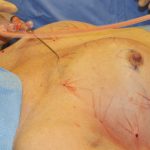
In the July 2009 issue of Plastic and Reconstructive Surgery, a task force from the American Society of Plastic Surgery reported on the current state of scientific knowledge about injectable fat grafting to the breast. Their recommendations are based on review of case reports and series and the few experimental studies which currently exist. Injectable fat grafting has been done in the breast for small breasts, deformities after breast implant augmentation and reconstruction, congenital breast deformities, and for nipple reconstruction. The total number of clinical cases numbers around 300 or so, which is a very small number of patients. There is only one registered prospective clinical trial with the FDA (BRAVA system)
The highlights of this report are worth summarizing:
1) Fat grafting may be considered a safe method for breast augmentation and correction of breast defects from cancer resection and its reconstruction and other medical conditions of the breast.
2) The longevity of fat grafts is unpredictable. Patients considering injectable fat grafting should be accepting of the potential of the need for additional treatment sessions to get the desired effect.
3) How well injectable fat grafts work is highly influenced by the surgeon’s experience and technique.
4) There is currently no one standard way to prepare fat grafts or inject them.
5) Changes in a patient’s weight can alter the size or shape of the retained fat graft.
6) Infection appears to be the only real medical risk and is usually solved by antibiotics.
7) High-risk breast cancer patients (family history of breast cancer, BRCA 1 and 2 positive) should be treated with caution. Although no evidence exists that fat grafting interferes with breast cancer detection, too few patients have been done to know with greater certainty.
8) Fat grafting is in its scientific infancy and more experimental and clinical research is needed to improve its survival after grafting as well as fully explore and develop its potential clinical uses.
For patients interested in autologous fat grafting to the breast, this report provides educated insight into its safety and cautious optimism about its potential. Unpredictable fat graft volume retention is its one downside.
Dr. Barry Eppley
Indianapolis, Indiana


